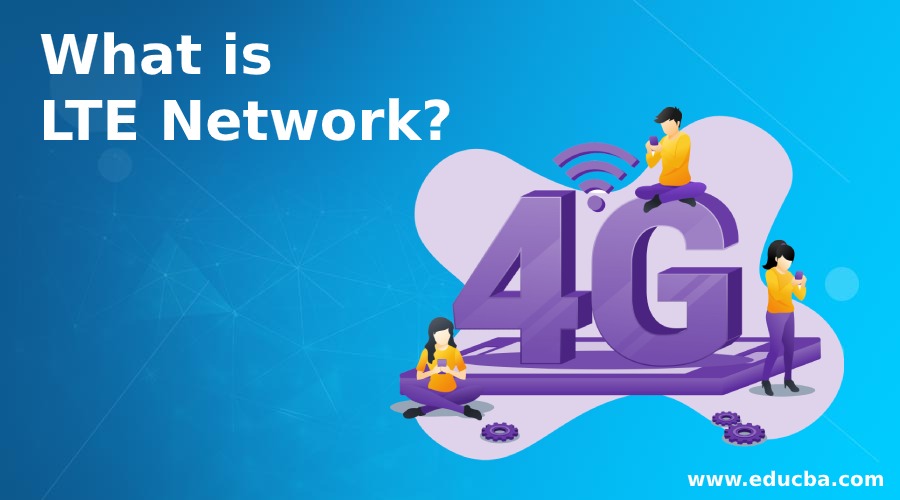Updated July 28, 2023

Introduction to LTE Network
LTE is expanded as a long-term evolution of 4G wireless communications to offer a maximum speed of 10x in a 3G network operatable in tablets, mobile phones, netbooks, wireless hotspots, and notebooks. LTE focuses on boosting the speed and capacity of wireless data based on digital signal processing and modulations executed at the millennium. The significant aim of LTE is to resize and simplify the network architecture with a system based on IP, reducing the latency. The wireless LTE interface is incompatible with 3G or 2G networks and operates using a separate radio spectrum.
Why do we use LTE Networks?
LTE provides a maximum data transfer speed, makes the life of mobile and internet users more convenient, and increases a person’s or enterprise’s productivity. But there are some constraints in the deployment of LTE. LTE doesn’t technically possess the real 4G, but some users are paying for this. Verizon indeed has a rapid network under LTE coverage, but people must make a reasonable payment. Updating all the towers is mandatory, requiring a significant payment from the user. Additionally, users must participate in a subscription plan if they desire higher speed.
Based on the requirement and thinking about the necessary installation of LTE, the mobiles should be robust and continuously upgrade. Rapid data perpetually implies the amount of larger data where the users try to depend on mobile devices. Faster data transfer also affects the device battery, which affects the battery’s lifetime. Battery life is a hot issue for mobile users, so the user should select his mobile devices with maximum battery capacity, which will better use the network and device.
How does LTE Network work?
- The process of LTE changes the existing methods of transferring the data into an IP system instead of moving a minor amount of data, similar to both GSM and CDMA.
- They also move full data packets to regulate and narrow down the service.
- The critical point of LTE is to consume the latency when transferring data.
- The principle of GSM is based on time delay duplex, whereas the CDMA is based on code division duplex.
- The coding data of both technologies is transmitted via airwaves.
- At the initial process, the GSM is marked as faster, and the globe follows its process in ages passed by; GSM is upgraded to HSPA, which is high-speed packet access followed by LTE by rapidly transferring the maximum chunks of information.
- Technicians think that both HSPA and LTE are substitutable terms.
- Verizon, located in the US, has the widest CDMA carrier and is proven to access the robust and rapid LTE network.
- Although, the LTE works on digital signal processing to provide the best adjudication at the transfer of data packets.
- Covering the entire process of wireless technology, the LTE marks itself as a supercharger for the CDMA or GSM mobile application, which is the circumference of the entire globe.
Features of LTE Network
Given below are the unique features:
- In the downlink process, the LTE network utilizes OFDMA, which enables multi-access by separating the single channel into a finite set of ortho subcarriers and grouping them based on the requirements of each user.
- In the uplink process, the SC-FDMA has used which single carrier of FDMA. But the limitation here is the presence of power fluctuations in the output signals; hence, using the special low-efficient linear amplifiers is mandatory. Single-channel FDMA is utilized due to the significant power consumption associated with uplinks. It becomes more effective in power supply which saves and follows the merits of OFDMA.
- Flexibility in the spectrum is an essential feature of LTE. In a framework where deployment depends on geographical location and involves the operation of users, systems, and services, the presence of variable regulations mandates the regulation of bandwidth flexibility. This regulation is implemented through in-band deployment.
- It can operate in both paired FDD and TDD, which is unpaired. It enables dynamic spectrum assignments to make better use of the radio spectrum. It can choose the users in a suitable prerequisite based on a channel condition of every frequency block and time moment. It involves the use of multiple antennas which have polarization diversity.
- It enables MIMO techniques that provide maximum data rate implementing parallel multiple channels. The uplink has power control which improvises the system’s capacity and minimizes power consumption. The process of LTE enables inter-cell inference coordination that finds the user placed at different centers and manages frequency interference of intercellular devices.
Advantages and Disadvantages of LTE Network
Given below are the advantages and disadvantages mentioned:
Advantages
- Implementing LTE highly regulates traffic management, decreasing data transmission traffic.
- It enables multiple users to work on the same frequency in a particular channel, that develops more mobile broadband users.
- It offers rapid data transfer, leading to maximum upload and download rates.
- If this ratio increases, it affects lagging in connection with the internet.
- LTE provides maximum data capacity and aims at voice-over IP.
- It supports many applications to work at maximum speed.
- It segregates the frequency in a variety of channels to preserve any occurrence of a disturbance in each channel.
- LTE facilitates SMS, and Voice calls in the existing network through generic access.
Disadvantages
- LTE’s limitation needs the antenna’s implementation at the base station to transmit data.
- Increases the implementation cost in network infrastructure.
Conclusion
To utilize LTE effectively and make the most of its advantages while overcoming minor limitations, it is advisable to install LTE at suitable locations.
Recommended Articles
This is a guide to What is LTE Network? Here we discuss the introduction to LTE Network, uses, working, features, advantages, and disadvantages. You may also have a look at the following articles to learn more –

